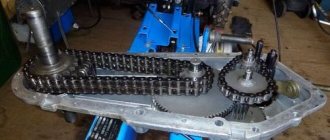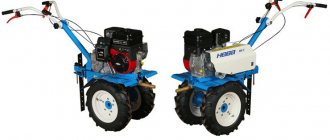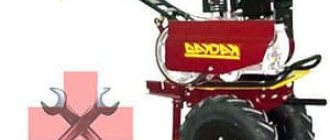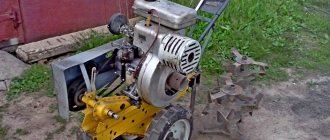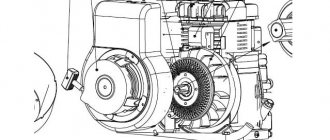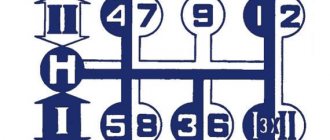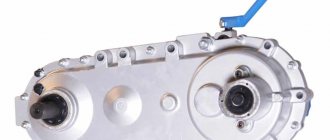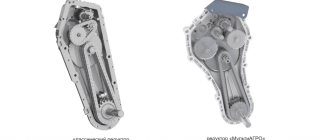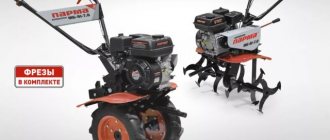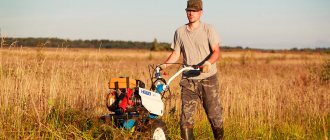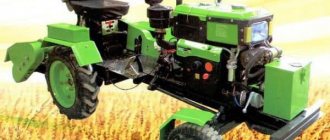Farming is a variety of agricultural work involving cultivating the soil, as well as caring for animals. This is a great way to provide your family with healthy and environmentally friendly products, as well as be able to sell vegetables and fruits and make money from it.
All farmers know how such work can be exhausting and even harmful to health. But we live in an age of technological progress, which means there is always special equipment on sale that makes the lot easier for everyone who owns large plots of land. Of course, such equipment will simply be unprofitable for those who have a garden of only about 2-3 acres, but those who own hectares simply cannot do without special machines.
In this article we will talk about the design of the gearbox - one of the main components of the Neva walk-behind tractor. About how to choose it and how to repair it if any malfunction is detected.
Types of gearboxes
According to their purpose, gearboxes are divided into the following types:
- Geared. The gear in them is in the form of a cylinder and a cone, and it is mounted on special shafts. According to its design, such a gearbox can operate in a straight line or in an angular pattern;
- Gear-worm. They are used when the engine crankshaft is vertical. This model includes a worm gear. Turns are performed at an angle of 90 degrees;
- Chain. A metal chain is used, which turns the sprockets;
- Belt. This is an analogue of the chain type, but here instead of a chain a belt in the shape of a wedge or rectangle is used, and sprockets are replaced by pulleys with profile grooves for fixing the belt.
Monoblock and reduction gear
It is quite possible to create a reduction gearbox for a monoblock with your own hands. They are used for modern monoblocks. Thanks to such gearboxes, the walk-behind tractor can be operated on difficult soils. It is necessary when the wheels slip and the vehicle does not have enough strength.
The design of the monoblock gear reducer directly depends on the design of the transmission. It moves the turning moment from the engine to the wheels, sets the optimal speed and direction of movement of the walk-behind tractor. The transmission device includes a gearbox, differential, gearbox and clutch. The gear type transmission has gears in the shape of a cone and a cylinder. Mounted on some types of equipment and heavy monoblocks.
In a reverse gearbox, the reversing process is carried out as follows: a coupling is located between the opposite gears in the shape of a cone. When it comes into contact with the spokes on the gears, the direction of rotation changes. Please note that the gears must be in the form of spirals.
Device engine
The Neva walk-behind tractor runs on three types of engines: from Japanese, Russian and American manufacturers. The choice of engine and model of equipment depends on what type of work will need to be performed, what load will be placed on the walk-behind tractor, and what type and condition of the ground.
For example, a DM-1 motor from a Russian manufacturer with a power of 5-6.2 liters. With. used as amateurs. It is not picky and easy to operate. It has a volume of 317, and the crankshaft rotates at a speed of 1200-1400 revolutions per minute. The Russian motor consists of a cylinder that is mounted vertically.
From Japanese parts, Subaru, Honda or Yamaha are installed on Neva equipment. Their power is 6-7.5 hp. They are considered more reliable and safe; in addition, they have an increased service life. Environmentally, Japanese models are harmless and have high performance.
American-made Briggs & Stratton engines are considered professional grade. Their power is 6-10 hp. Its advantages include less oil use, wear resistance and high performance. This is due to the inclusion of a cast iron cylinder liner, speed controller and a forged durable crankshaft.
Gearbox products
Please note that you must not forget to change the oil in the gearboxes. If you miss this point, after some time the additives lose their properties. To increase their service life, their characteristics must be protected with oil. Failure to replace it in a timely manner may cause the product to foam, resulting in the gearbox jamming.
Before changing the oil, you need to check the previous level, then remove the oil dipstick and clean it with a soft cloth. The monoblock gearbox should be filled with oil at a medium level.
Oil is the key to long-term operation of the gearbox. When looking for the best product, be sure to read the instructions. It is important to consider the conditions under which it will be used. The most popular oil is the Motul brand, which is used by almost all owners of walk-behind tractors.
Gearbox of the Neva walk-behind tractor
Gearbox of the Neva walk-behind tractor - design and features
For walk-behind tractors, you can purchase a variety of attachments that allow you to perform different jobs - from plowing the land to sweeping the area and mowing lawns.
All these tools move thanks to the walk-behind tractor gearbox. We will look at the design of the gearbox for the Neva. It is necessary to transmit the rotation of the motor to the wheels and any attachments. It sets the direction of rotation and the gear ratio. In principle, the gearbox for the Neva walk-behind tractor is no different from any other device. They are all very similar.
The gearbox is designed in such a way that on the upper part of its housing there are elements for shifting gears. The gear lever has five positions. When the lever is pressed, the fork releases the clutch from the clutch, and vice versa - when the lever is released, the fork returns back.
The walk-behind tractor will slow down when the drive is connected to the right axis. The torque comes from the sprocket located near the input shaft. When the lever is pressed, the left sprocket engages and a downshift is engaged. When the handle is pushed to the limit, the highest gear will engage.
Possible breakdowns of the gearbox of the Neva walk-behind tractor
Oil must be poured into the gearbox of the walk-behind tractor. You need to make sure that the oil level is sufficient. Many people wonder what kind of oil to fill in the gearbox. It is important that it is of very high quality and from a reputable manufacturer, so that the entire system works properly and lasts a very long time.
To repair the gearbox, it is necessary to disassemble it. But first you need to clean all the dirt and drain the oil. After this, careful disassembly is carried out and the origin of the breakdown is found. You can visually inspect each component and find breakdowns, or mechanically test the parts. If you discover a breakdown and you need to replace one or another component, be sure to buy and install only new parts and only genuine ones, if, of course, you value your unit. Changing the oil in the gearbox of the Neva walk-behind tractor is a mandatory and final step in the repair process. If you don't do this, the device will simply fail.
Possible breakdowns:
- Oil flows along the shift shaft. It may not even be necessary to repair the gearbox. You need to first check the presence and quantity of oil. After this, you can replace the oil with new one and drain the excess. Another reason is cuff wear. To do this, you need to carefully examine the device and replace the damaged part;
- Oil flows through the output shaft. This also requires cuff replacement. The origin of the breakdown is wear of the axle cuff edge;
- There is no kinematic connection inside the gearbox. This comes from a sprocket break in the block. To repair the gearbox in this case, you need to completely inspect it and replace all faulty sprockets;
- The gearbox is jammed. You need to study it and replace the broken circuit;
- Gears will not engage or shift. There may be several reasons for a malfunction here. The first is that the switching pin is damaged. The second is that the thread of the gear shift knob is cut off. You can fix the breakdown yourself by simply replacing parts.
It should be noted that you will not need gearbox repairs for a long time if you use high-quality oil, monitor its level and change and fill in new ones on time, and also operate the equipment carefully, without overloading.
Failure of the gearbox of the Neva MB-2 walk-behind tractor
Correcting Neva MB2 gearbox breakdowns is practically no different from other models, but there are still some points that need to be mentioned. Our advice will help you not only identify the problem, but also decide whether you can repair it yourself or whether you will need to call a professional.
- The crankshaft has stopped rotating. Repair is definitely needed here, since the reason may lie either in the destroyed ratchet body or in the ratchet clutch. You must examine and unscrew the device and replace all damaged elements;
- White smoke began to come out of the muffler when you turned on the equipment. The electrodes of the spark plug may remain dry, but they are covered with a white coating. The reason is a lean mixture. To fix it, you need to adjust the carburetor;
- The engine suddenly starts to slow down and stops altogether. Your engine may simply be overheated. You need to stop work and do not turn on the equipment until it has completely cooled down. You also need to check the oil level and clean the surface of the block and cylinder head from dirt.
Simple operating rules allow you to avoid any breakdowns. If they do arise, you should definitely study the operating instructions, where you will find answers to any questions. It will also describe in detail all types of breakdowns and how to fix them. This must be done, since for different models of walk-behind tractors the methods for finding and fixing the problem may differ to some extent.
Owner reviews of the walk-behind tractor
Reading information on the website of a walk-behind tractor manufacturer or a dealership will never give you a completely objective picture of the equipment. No one in their right mind would criticize their product, even if there is a reason for it. Therefore, we will turn to real Neva users for feedback.
- I purchased a Neva-MB2 walk-behind tractor. Everything that is available is factory produced. For hilling and plowing, I purchased different wheels with lugs, filled them with concrete to make them heavier, now there is no need to push when hilling and autumn plowing. In the spring we mill the area, with additionally purchased cutters the grip is approximately 1.1 m. We plan to purchase a potato planter. In two years of use there were no breakdowns, I am quite satisfied with the purchase.
- Neva with a 6.5 hp engine. I have been using it since 2001. For my 30 acres there is enough, although this is the limit; it is masochism to treat a large area with such a technique. I carry out a full range of work on cultivating potatoes. There were no problems mowing with the Zarya rotor; if you wish, you can make hay for a decent number of livestock. On the trailer it pulled a maximum of 500 kg, if you load it more, it won’t pull it even on the gentlest climb, the weight is too small for this in the walk-behind tractor itself.
- In my opinion, it is too light, it weighs 98 kg and this is clearly not enough; you have to push it when plowing and your hands get tired quickly. On slopes it is very unstable and falls on its side. I think that for light soils it is easier to take a cultivator, but for difficult conditions you need a more serious walk-behind tractor.
- Became the owner of a Neva with a Subaru EX21-7 hp engine. I recently purchased it, but so far my impressions are positive. I deliberately chose a Japanese engine, since I believe that they have no equal in mechanical engineering; it starts with a casual movement of the hand; in general, there can be no complaints about the engine. If you give more revolutions, the gearbox makes a suspicious noise, but God bless it, as long as it doesn’t break. It is difficult to get to one of the engine mounting bolts when the belt is tensioned, this is a minus. I also redid the place where the clutch cable was fixed; the belt was not tensioned well and was slipping; the adjustment did not help. Light weight is also a minus, but the problem is completely solvable; installing weights is not difficult. But overall the device is quite decent.
Motoblock gearbox Cascade
What does the gearbox of the Cascade walk-behind tractor consist of?
In order to disassemble the gearbox of the Cascade walk-behind tractor, you first need to remove it from the walk-behind tractor. Then you need to remove the covers, then remove the screws and tap to remove the cover. Remove the input shaft bushing, remove the shift lever and shift fork. Remove the input shaft with the gear on it. Remove the shaft from the bushing and remove the chain from the shaft. After which it is necessary to remove the shaft block itself. Take out the sprocket block. Remove the intermediate shaft with gears. Remove the right axle shaft, clutch and left axle shaft.
The gearbox consists of the following main parts:
- covers;
- pulley;
- bearings;
- bushings (input shaft);
- shift lever;
- intermediate shaft gear;
- shift axis, shift fork;
- input shaft with gear;
- shaft block;
- double-row chain;
- connector, small circuit;
- sprocket block;
- intermediate shaft with gear;
- input shaft;
- washers;
- oil seals;
- right axle shaft;
- double star;
- clutch;
- left axle shaft;
- clutch fork;
- bracket;
- spring.
The influence of oil on the operation of the gearbox of the Cascade walk-behind tractor
Particular attention should be paid to the lubricating fluid and oil. It is worth noting that the oil must be changed every 50 hours of operation of the walk-behind tractor. Also, you should not heavily load the walk-behind tractor, as this can lead to rapid wear of the equipment. Do not forget that installing additional cutters with your own hands is undesirable. The gearbox chains suffer greatly from additional loads (the bushings burst), after which the chains begin to jump. Under strong lateral loads, the support washer quickly wears out, as a result of which the alignment of the two gears is lost and the bushings fly off the chain. The conclusion can be drawn as follows: you do not need to work on the walk-behind tractor at an angle; despite cleaner work, you are harming your unit and you should turn the walk-behind tractor more carefully when working.
The oil change is carried out as follows:
- First, we place the walk-behind tractor on a flat surface and find a rod about 70 centimeters long.
- We bend the rod into an arc and insert it into the filler hole of the gearbox through the entire body of the gearbox until it stops and stick the rod out.
- Next, look at the oil level in the gearbox. Ideally, the oil should be filled to at least 25 cm. Then either add oil (1.5 liters) or pour oil into the dry gearbox (2 liters). The oil must be filled as specified by GOST; in addition, it is permissible to mix different types of oils in any ratio.
Replacing the oil seal in the gearbox of a Cascade walk-behind tractor
Next, we will outline how to replace the oil seal on the gearbox of a Cascade walk-behind tractor. Replacing the oil seal occurs as a result of leaks, which will lead to rapid wear of parts, because the gearbox will operate dry, i.e. no oil. The main reasons for oil seal failure are: a shaft with burrs or roughness that wears down the oil seal; deformation of the oil seal due to improper installation; poor workmanship; the spring that tightens the edge is weakened; and just wear and tear. In order to replace the oil seal, you first need to clean the dirt, then pull out the oil seal with a catchy movement, after which, using a suitable socket head, you need to drive the new oil seal until it stops lightly, lubricating it with machine oil. However, if there is metal protection, then it is necessary to disassemble the gearbox.
Motoblock Neva and attachments for it: care and safety precautions
No matter what model of walk-behind tractor you use, it needs regular maintenance and repair to ensure maximum longevity. First of all, the engine of the unit needs regular diagnostics and cleaning. The part that wears out the most quickly here is the air filter. It must be cleaned after every 25 hours of use of the walk-behind tractor, and the cartridge in it must be changed every 100 hours. If work is carried out in particularly dusty conditions, then this must be done more often.
The Neva walk-behind tractor is easy to use, but requires regular maintenance
The motor cooling fins and the mesh at the inlet of the air cooling fan also need regular cleaning. Before cleaning them, the walk-behind tractor must be turned off. In addition, check the oil level every day and completely change it every 25 hours of operation. Replacement must be carried out when the engine is warm.
Before working with a walk-behind tractor, make sure that you know the purpose of all its controls, adjust the height of the steering handles to your height, and disconnect the power drive from the engine. Carefully monitor the condition of the mechanism's wheels; low pressure in them can lead to slipping and a significant reduction in the maneuverability and efficiency of the unit.
If you own a large plot of land, then you should definitely buy a Neva walk-behind tractor. Prices for various models of this unit are relatively low, and the difference between using a walk-behind tractor and manual labor will be felt immediately.
How to do it yourself?
If you have access to a huge selection of necessary spare parts, then, of course, it is easier to make gearboxes yourself. But please note that such a spare part requires serious metal processing equipment. If you have this, then you can choose a housing with optimal parameters, make holes for the shafts on the bearings and make the device no worse than at the factory.
Initially, you need to calculate the rated power without errors. Thanks to the correct results, you will be able to find out the optimal angle to find for a bevel gear. You need to calculate the number of rotations in 60 seconds.
The completed gearbox requires determination of its operating conditions, including the load. Its functioning will be at the highest level if the temperature and lubricant are chosen correctly. The next step is to assemble the gearbox. The case can be taken from the factory. According to its diameter, you can determine the bearing housing for the shaft. A caliper and a drill will help you with this.
A steel flange must be mounted on the front side of the gearbox. Inside we mount a flange bearing and a washer. The flange is secured with screws at the generator itself. The key and gear must be selected in advance. All components that are in contact with the transmission system are fixed to the rotary generator.
